From Ancient Egypt to Modern Runways: Discovering the Fascinating History and Evolution of Sparkly Decorative Discs
Sequins have sparkled their way through history, from ancient Egypt to modern fashion runways. These tiny discs of shimmering material have adorned clothing and accessories for thousands of years. Sequins were originally made from gold and used on royal garments in Egypt, symbolizing wealth and status.
The word “sequin” comes from the Arabic term “sikka,” meaning coin. This reflects their early use as currency-like decorations. Over time, sequins evolved from precious metals to more affordable materials like plastic and Mylar. This change made them widely available for use in everyday fashion.
Sequins have survived wars, economic changes, and shifting fashion trends. They’ve been used on everything from flapper dresses in the 1920s to Michael Jackson’s iconic glove. Today, sequins continue to add glamour and shine to outfits for special events and everyday wear.
Table of Contents
Key Takeaways
- Sequins have a rich history dating back to ancient Egypt
- The materials used for sequins have changed over time, making them more accessible
- Sequins remain popular in fashion for their ability to add sparkle and glamour to outfits
Historical Evolution of Sequins
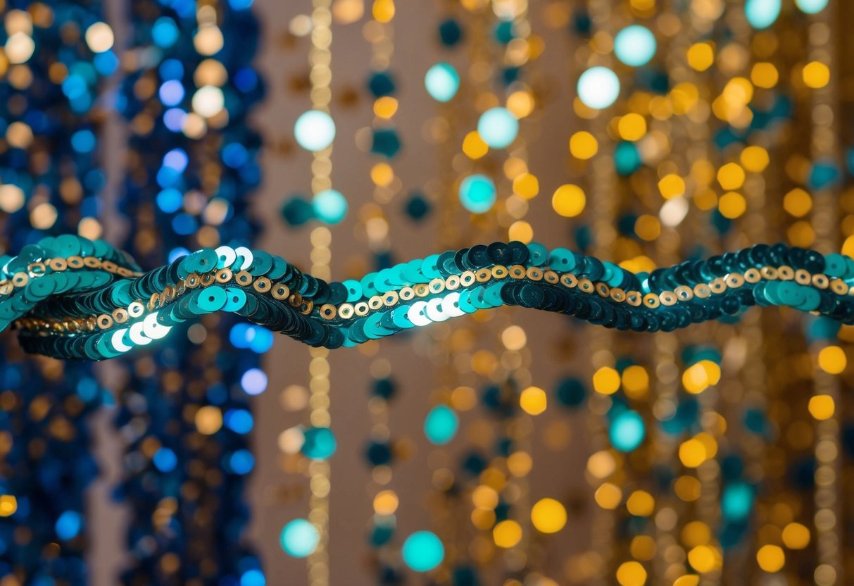
Sequins have a rich history dating back thousands of years. Ancient Egyptians used gold disks on their clothing, as seen in King Tutankhamun’s tomb discovered in 1922.
The word “sequin” comes from the Arabic “sikka,” meaning coin. This shows the long-standing link between sequins and wealth.
In the 13th century, Venetians made gold sequins as actual coins. Over time, sequins became purely decorative items sewn onto clothes.
Early sequins were made of metal. They were heavy and could rust or tarnish. In the 1930s, gelatin sequins became popular. These were lighter but melted easily.
A big change came in 1952 when DuPont invented Mylar. This new material revolutionized sequin production. Mylar-coated plastic sequins were durable and could survive washing machines.
Sequins gained massive popularity in the 1970s and 1980s. Celebrities like Michael Jackson helped make them a fashion staple.
Today, sequins are made from various materials including plastic, metal, and eco-friendly options. They continue to add sparkle to fashion and costumes worldwide.
Material and Manufacture
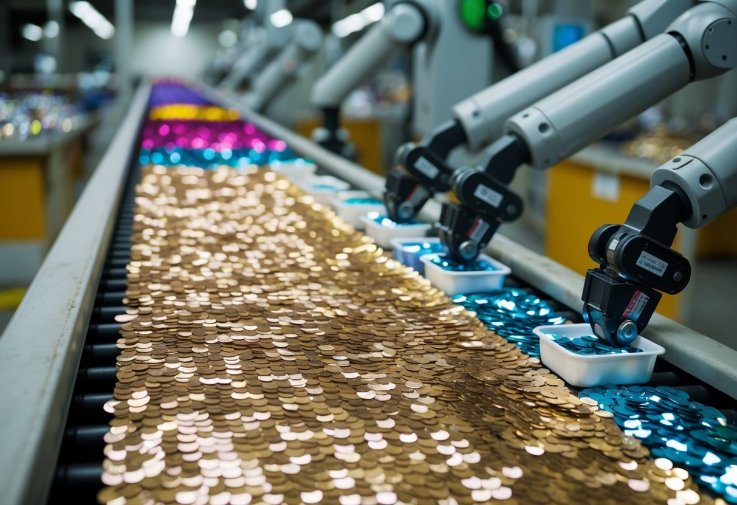
Sequins have evolved from metal discs to lightweight plastic options. Their production methods have changed over time to create the sparkly decorations we know today.
From Metal to Plastic
Early sequins were made of metal. They were heavy and expensive. In the 1930s, manufacturers switched to gelatin. Gelatin sequins were lighter but melted easily.
The next step was plastic. Vinyl became popular for making sequins. It’s durable and comes in many colors. Today, most sequins are made from polyethylene terephthalate (PET). This plastic is lightweight and shiny.
Some eco-friendly options have appeared recently. These include sequins made from recycled plastic bottles. There are also bio-based sequins made from plant materials like corn.
Manufacturing Techniques
Sequin production has become more efficient over time. Machines now do most of the work. The process starts with thin sheets of plastic.
These steps create sequins:
- Punching shapes from plastic sheets
- Adding color through dyeing or coating
- Creating holes for sewing
- Applying special finishes for extra shine
Modern techniques allow for different shapes and sizes. Sequins can be flat, cupped, or holographic. Some have special coatings to resist water or heat.
Mass production keeps sequins affordable. Factories can make millions of sequins quickly. This helps meet the high demand for sparkly decorations in fashion and crafts.
Cultural Significance
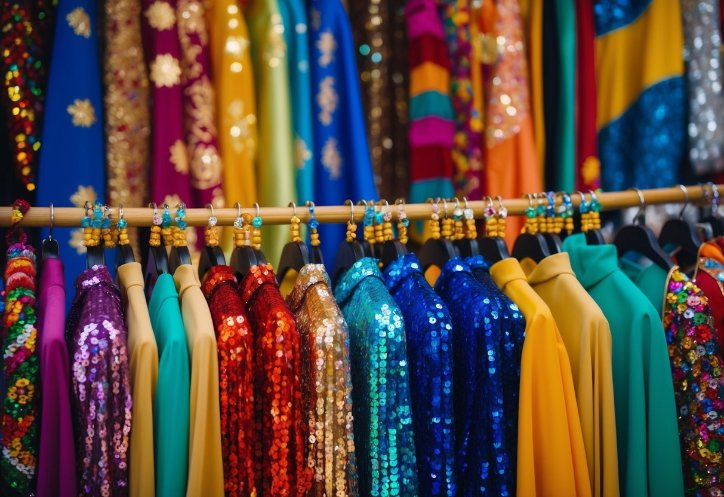
Sequins hold deep meaning in many cultures beyond just fashion. They have roots in ancient traditions and continue to play important roles today.
Fashion Industry
Sequins are a staple of glamorous fashion. Designers use them to create eye-catching looks on red carpets and runways. Sequined dresses often appear at formal events like galas and award shows.
Many view sequins as a symbol of celebration and joy. Wearing sequins can boost confidence and make people feel special. Some see sequins as a way to stand out and express themselves.
In recent years, sustainable sequins have gained popularity. Brands now make eco-friendly options from recycled plastic.
Pop Culture and Performance
Sequins are closely tied to entertainment and show business. Many famous performers are known for their sparkly outfits. Michael Jackson’s iconic sequined glove is a prime example.
Sequins feature heavily in dance costumes, especially for styles like ballroom and jazz. They catch the light and add drama to stage performances.
TV shows and movies often use sequined costumes to create a sense of glamour or fantasy. Think of classic Hollywood musicals or modern singing competitions.
Music videos and concerts also rely on sequins for visual impact. Pop stars like Lady Gaga and Elton John are famous for their glittery stage looks.
Design and Aesthetics
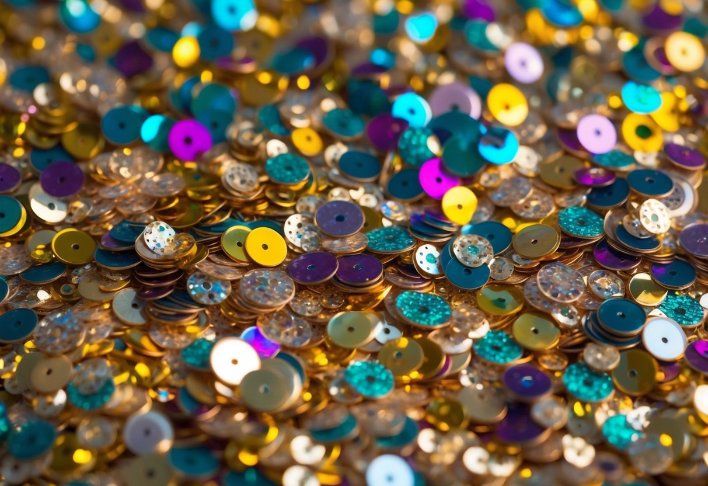
Sequins offer endless design possibilities through their patterns, colors, and light-reflecting properties. These tiny discs can transform garments and accessories into dazzling works of art.
Pattern and Color
Sequins come in a wide range of shapes and sizes. Round sequins are classic, but designers also use oval, square, and even custom-shaped sequins. Some popular patterns include chevron, ombré, and geometric designs.
Color options are vast. Metallic hues like gold, silver, and rose gold are common. But sequins also come in every color of the rainbow. Some even change color when brushed in different directions.
Many designers mix sequin sizes and colors to create depth and visual interest. This technique can produce stunning effects, especially under stage lights or in photographs.
Light Reflection and Texture
Sequins are known for their ability to catch and reflect light. This quality makes them perfect for evening wear and stage costumes. The way sequins move and shimmer can create a mesmerizing effect.
Flat sequins offer a smooth, sleek look. Cupped sequins add more dimension and sparkle. Some sequins have holographic finishes that change color depending on the viewing angle.
Texture is another key aspect of sequin design. Dense sequin coverage creates a scale-like effect. Looser application allows the base fabric to show through, creating a more subtle shimmer.
Designers often combine sequins with other materials for contrast. Pairing sequins with matte fabrics or embroidery can create striking visual effects.
Application Techniques
Sequins can be attached to fabric using two main methods: sewing and adhesives. Each technique has its own advantages and works best for different projects and materials.
Sewing Onto Fabric
Sewing sequins is a durable method that works well for clothing and accessories. It requires basic sewing skills and some patience.
To sew sequins, use a needle and thread that match the sequin color. Start by anchoring the thread on the fabric’s wrong side. Bring the needle up through the fabric and sequin hole, then back down.
For a secure hold, pass the needle through the sequin twice. This creates a figure-eight stitch. Continue adding sequins in rows or patterns as desired.
When sewing many sequins, try using a sewing machine with a special sequin foot. This speeds up the process for large areas of coverage.
Adhesive Methods
Gluing sequins offers a quick, no-sew option for adding sparkle to fabric, paper, or other surfaces. It works well for temporary designs or when sewing isn’t possible.
Choose a strong fabric glue or craft adhesive that dries clear. Apply small dots of glue where you want sequins. Use tweezers or a wax-tipped tool to place sequins on the glue dots.
For precise placement, put glue on a pencil tip and use it to pick up and position sequins. This method works well for scattered or individual sequin designs.
Let the glue dry completely before handling the item. Some adhesives may not be washable, so check the product instructions for care guidelines.
Sustainability Concerns
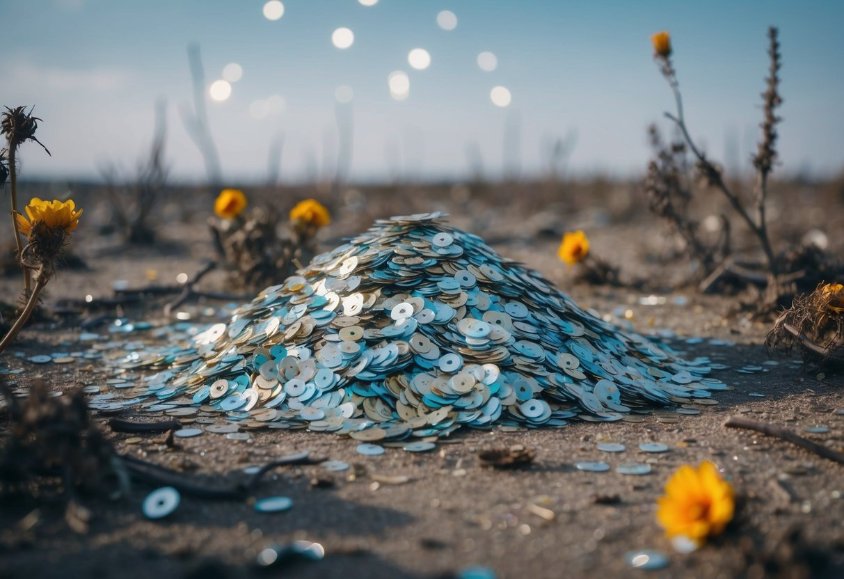
Sequins pose significant environmental challenges. Most are made from non-biodegradable plastics that persist in ecosystems for thousands of years.
These tiny decorations often shed from garments, contributing to microplastic pollution in waterways and soil. As they break down, sequins release harmful chemicals.
The production of sequins is energy-intensive and typically relies on fossil fuels. This process generates substantial carbon emissions, adding to fashion’s already large environmental footprint.
Traditional sequins are difficult to recycle due to their small size and mixed material composition. Many end up in landfills or incinerators after a brief period of use.
Some companies are developing more eco-friendly alternatives. These include sequins made from recycled materials or biodegradable substances like cellulose.
Sustainable sequin options can help reduce waste and pollution. However, they currently represent a small fraction of the market.
Consumers can make a difference by choosing garments with sustainably-produced sequins or opting for sequin-free styles. Proper care and repair of sequined items can also extend their lifespan.
Maintenance and Care
Proper care is key to keeping sequined items looking their best. Most sequined clothing should be dry cleaned to avoid damage. Check the care label first, as some pieces may allow gentle hand washing.
Never put sequined garments in the dryer. The heat can melt or damage the sequins and fabric. Instead, lay items flat on a clean towel to air dry. This prevents stretching or distorting the shape.
Storing sequined clothing correctly is important. Hang items on padded hangers or fold them carefully. Place tissue paper between folds to prevent sequins from snagging. Store in a cool, dry place away from direct sunlight.
Before wearing, gently steam sequined items to remove wrinkles. Be careful not to apply heat directly to the sequins. A light misting with a fabric refresher can help eliminate odors between cleanings.
Handle sequined garments with care. Avoid rubbing against rough surfaces that could snag or pull off sequins. When sitting, smooth the fabric to prevent creasing or damage to the sequin design.
With proper care, sequined clothing can maintain its sparkle for many wears. Regular maintenance keeps these eye-catching pieces looking their best for special occasions.
Future of Sequins in Fashion
Sequins are set to sparkle even brighter in the coming years. New technologies and changing tastes will shape how these shiny discs are used in clothing and accessories.
Technological Innovation
3D printing may revolutionize sequin production. This could allow for custom shapes and sizes beyond the typical round disc. Smart sequins with color-changing properties are in development. These could react to light, heat, or even the wearer’s mood.
Eco-friendly sequins made from plant-based materials are gaining traction. Some brands are experimenting with biodegradable options. This addresses concerns about plastic pollution from traditional sequins.
Nanomaterials may lead to ultra-thin, lightweight sequins. These could add sparkle without bulk. Advances in adhesives could make sequined garments more durable and washable.
Emerging Trends
Sequins are breaking free from formal wear. Casual sequined pieces like t-shirts and sneakers are becoming popular. This trend blends glamour with everyday style.
Designers are using sequins in new ways. Ombre effects, mixed textures, and geometric patterns are on the rise. Oversized sequins and paillettes are making a comeback.
Men’s fashion is embracing sequins more openly. Sequined jackets and accessories for men are hitting runways. Genderless sequined designs are also gaining popularity.
Digital influencers are driving sequin trends. Social media challenges featuring sequined outfits spark new ideas. Virtual fashion shows may showcase even bolder sequin designs.
Frequently Asked Questions
Sequins have a rich history in fashion and beyond. They’re made from various materials through specialized processes and have seen popularity in different eras. Their use also raises some environmental concerns.
How were sequins historically used in fashion?
Sequins began as small coins sewn onto clothing. They added sparkle and showed wealth. Kings and queens wore sequined outfits to look fancy. Over time, sequins became smaller discs made just for decoration.
What materials are commonly used to make sequins?
Today, most sequins are plastic. Some are metal or glass. Mylar, a type of plastic film, is often used to coat sequins. This makes them shinier and tougher. Some eco-friendly sequins use plant-based materials.
Can you describe the manufacturing process of sequins?
Sequins are cut from sheets of material. Machines punch out tiny circles or other shapes. Holes are added for sewing. Some sequins get coatings for extra shine. They’re then sorted by size and color.
In what ways are sequins utilized outside of the fashion industry?
Sequins aren’t just for clothes. They’re used in craft projects and home decor. Some artists use sequins in mosaics or sculptures. Sequins can make signs and displays more eye-catching. They’re even used in some scientific and industrial settings.
What are some notable periods in history where sequins were particularly popular?
The 1920s saw a big sequin boom. Flappers loved sparkly dresses. Sequins had another big moment in the 1970s disco era. The 1980s brought sequins to pop culture, with stars like Michael Jackson wearing them.
How do sequins impact the environmental sustainability of apparel?
Plastic sequins can be bad for the earth. They don’t break down easily. When washed, they can shed microplastics. Some companies are working on eco-friendly options. These include sequins made from plants or ones that dissolve in water.
Related Post: What You Need to Know About Sequins: A Comprehensive Guide to Sparkly Fashion

